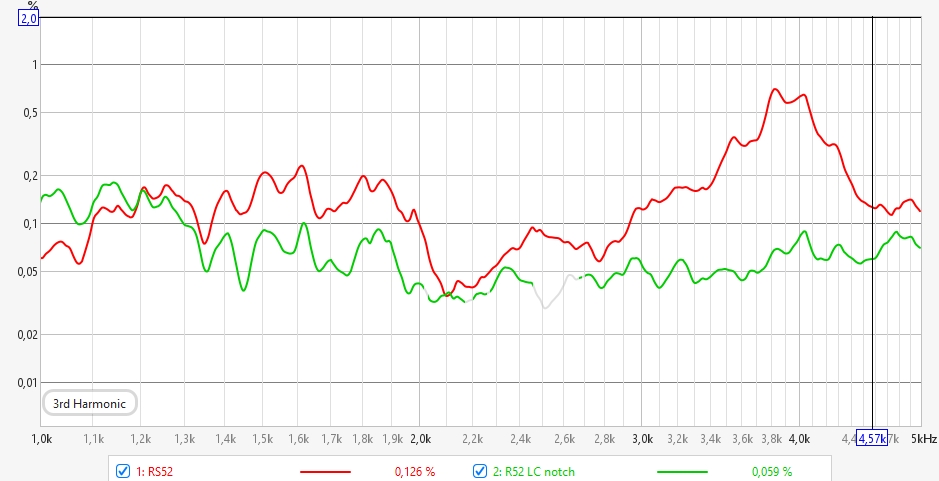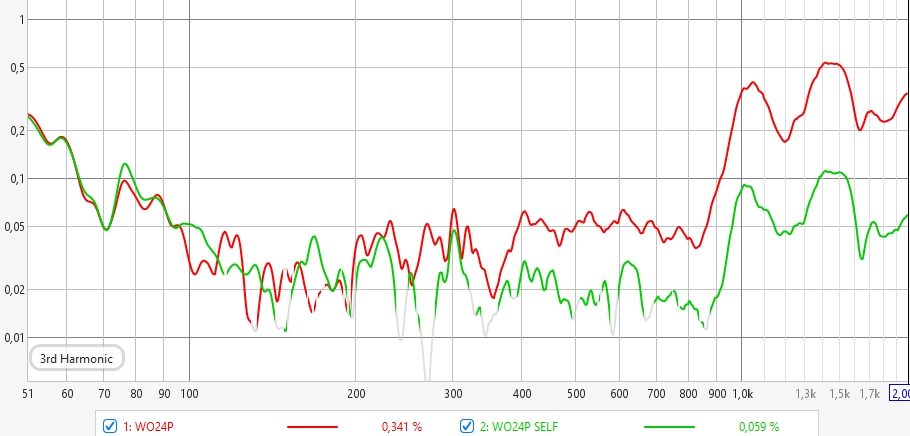Speaker Break-Up and how to reduce his distortion
Introduction
Loudspeakers, despite their crucial role in sound reproduction, can introduce unwanted distortion.
One significant contributor is cone break-up, a phenomenon related to the moving material (diapragm, cone..) resonance at high frequencies.
This article dives deeper into the science behind cone break-up, its impact on sound quality, and explores filtering techniques to mitigate this issue.
Causes of Cone Break-Up
Cone break-up occurs when the loudspeaker cone resonates at high frequencies, causing it to vibrate in unwanted ways beyond its intended pistonic motion. Several factors influence this resonance:
-
Dimensions, Thickness, and Shape of the Cone:
The size, thickness, and curvature of the cone significantly impact its resonant behavior. Thinner or flatter cones tend to break up earlier than rigid or curved ones. -
Cone Material:
Different materials possess varying stiffness and damping properties. Stiffer materials like metals are more prone to break-up, while materials with inherent damping, like treated paper or composites, can help reduce it. -
Boundary Conditions of the Cone:
How the cone is secured to the frame (suspension) also plays a role. A flexible suspension allows for a wider range of motion before break-up occurs, while a stiffer suspension might limit total excursion but could lead to earlier break-up at specific frequencies.
Impact of Cone Break-Up on Distortion
When the cone breaks up, it generates standing waves that distort the original audio signal.
These distortions manifest as harmonic distortion, perceived as a coloration or harshness in the sound, a H3 distorion at 1khz, so create by a 1khz signal alone, will create sound at 3khz (3 times fundamental).
When a violent break-up occur at 1500Hz, we have a H3 rise-up at 500Hz (1500/3), so even if we cut at 1kHz we will have the distortion associated to the break-up in the signal and when we will play 500hz we will have an unwanted signal at 1500Hz.
Breakup will also bring temporal problems and out of plane wave radiation behavior, expecially visible with compression drivers in horns.
Cone Break-Up and Electrical Current
The speaker cone is a mechanical system. When it encounters its resonant frequency, it tends to vibrate in uncontrolled ways – this is cone break-up.
This uncontrolled motion is related to the electrical current flowing through the voice coil.
As the cone vibrates, it generates a back electromotive force (EMF) that opposes the current flow and create current distortion in the voice coil.
Inductance and Impedance
An inductor opposes changes in current flow. When you increase the inductance in the circuit (like the inherent self-inductance of the voice coil or by adding an external inductor), the overall impedance of the circuit also increases.
Impedance acts like electrical resistance for AC signals like audio.
How Increased Inductance Helps
Here’s how increased inductance tackles cone break-up:
-
Limits Current Flow at Resonance: At the cone’s resonant frequency, the back EMF from the uncontrolled vibration is strongest. The increased inductance makes it harder for the current to rise significantly at this frequency. This reduces the electrical energy delivered to the voice coil, thereby lessening the uncontrolled movement of the cone.
-
Partial Damping Effect: Though not a traditional damping mechanism, the increased opposition to current changes caused by the inductance can have a damping effect. This helps to suppress the excessive vibration of the cone at resonance.
However, it’s important to consider these points:
-
Limited Effect: Increased inductance alone might not entirely eliminate cone break-up, especially for severe break-up issues. It’s often a contributing factor in conjunction with other design elements like cone material and suspension.
-
Frequency Dependence: The impedance increase due to inductance is most significant at higher frequencies. So, the effectiveness in mitigating break-up depends on the resonant frequency of the cone relative to the desired operating range of the woofer.
Filtering Techniques for Break-Up Reduction
Several filtering techniques can be employed to address cone break-up and reduce associated distortion.
As it’s based on impedance rise-up, an EQ in DSP will not have an impact.
The result is depending of woofer’s motor but it will impact mainly the H3 in most cases. It depends on the design of the motor, the voice coil and the inductance value, the lower and more linear it is, the less there is current distortion and distortion in the medium (i.e. a plateau distortion which is not linked to the excursion), which explains why a notch has no effectiveness on the distortion of compressions and tweeters as well as other speaker as 18Sound AIC speakers.
It’s important to note that these filtering techniques are most effective when the break-up rise up in frequency (one or more big peaks) and/or when woofer is rising up in his final box. If the breakup is already damped, so more or less flat and the woofer has already a flat response in box, it will useless to try something about it.
Each with its advantages and limitations:
Notch Filters
These passive filters use a combination of inductors (L) and capacitors (C) to create a high impedance at the resonant frequency. This effectively reduces the current flow at that frequency, minimizing cone excitation.
However, precise tuning is crucial and if certain components are placed in parallel with the circuit, this will bypass the impedance effect and make the notch effect on breakup distortion ineffective. So it will work well in conjunction with active filtering, less in passive filtering.
Here is the H3 of a Dayton RS52 with and without LC notch :

Air core inductors with active filtering
These first order filters, in serie, often implemented with a single inductor, allow lower frequencies to pass through while attenuating higher frequencies, including those near the break-up point. This approach offers a simpler design and also linearize the woofer, it’s the easier solution.
It will increase gradually the impedance and linearize the woofer in the same time, it works very well if the woofer is already rising up in his final box and need linearisation.
The inductor must be an air core inductors and not an iron core inductor otherwise it will adds H3 in the low ends.
Here is the H3 of a SbAcoustics WO24P with and without air inductor in serie :

Compensation Networks
More complex networks can be designed to address specific break-up modes. These may involve additional components and require detailed analysis of the cone’s behavior.
Self Inductance
While not a filter in the traditional sense, the inherent self-inductance of the voice coil can also contribute to a rise in impedance at higher frequencies.
This can have a similar effect to filtering, potentially mitigating break-up to some extent.
However, it’s often a secondary effect and may not be sufficient for significant break-up control.
Conclusion
Cone break-up is a significant factor in loudspeaker distortion, impacting sound quality.
By understanding its causes and employing targeted filtering techniques like notch filters or high-pass filters, speaker designers can achieve smoother, more accurate sound reproduction.